#NetworkSlicing
Explore tagged Tumblr posts
Text
#NetworkSlicing#5GInnovation#Telecom#FutureConnectivity#MarketsandMarkets#DigitalTransformation#Timestech#SmartNetworks#NextGenInfrastructure#IoT#EdgeComputing#SmartCities#TelcoTrends#electronicsnews#technologynews
0 notes
Link
#5G-Advanced#digitalsovereignty#edgecomputing#NetworkSlicing#NeutralHostModels#OpenRAN#smartinfrastructure#spectruminnovation
0 notes
Text

(2025-03-02 image ©standard.co.uk) Ireland beat Wales in the 6 Nation a week back. What has this go to do with mobile phone technology?
Vodafone had their 5G SA [Stand Alone] network working in the Principality Stadium and within that they were running network slicing. So one one slice live commentary was given and on another the official photograph agency could upload images. The rest of the network was open for everyone else to use. This was a test, but a test under heavy load with nearly 75,000 people in the stadium and (at a guess) 20,00 plus on Vodafone.
Network Slicing is a 5G technology that allows the mobile operator, Vodafone in this case, to split the available channel so that the dedicated channels work are separate from the rest of the network and those allowed to use it get the service they need. Vodafone (and their technical partner, Ericsson) must also ensure that the remaining part of the channel, open to the general public, still. has a good connection.
We will see many more examples of network slicing in future on all UK networks. There are some moral issues for the network operators to answer, making sure that slices are not used by commercial operators to the detriment of others. One can imaging Disney or Netflix or gaming companies wanting dedicated slices and if granted the general public could be left with a poor service.
0 notes
Text
youtube
Network Slicing: A Conversation with Lucintel and DGS
0 notes
Text
youtube
Session 20: Cloudification in Open RAN - The Shift from Traditional to ORAN
Video Link - https://youtu.be/6crjHxeWXL4
Cloudification in Open RAN refers to the transformation of traditional, hardware-centric radio access networks (RANs) into more flexible, software-driven architectures based on open standards. This session will explore the concept of cloudification in Open RAN and the benefits it offers over traditional RAN deployments.
Subscribe to "Learn And Grow Community" Follow #LearnAndGrowCommunity
#Cloudification#openran#oran#virtualization#NetworkSlicing#MEC#MassiveMIMO#wirelesscommunication#telecommunications#ranintelligentcontroller#ric#cu#centralizedunit#du#Distributionunit#orchestration#NetworkOrchistrator#beginnersguide#5g#4g#5gnr#5grevolution#3gpp#telecominsights#telecominfraproject#networkarchitecture#protocolos#rrc#protocollayers#networkchannels
1 note
·
View note
Text
5G Network Strategies

ChatGPT
To fully capitalize on the monetization opportunities presented by 5G, operators need to embrace collaboration across ecosystems and seamless integration with digital marketplaces. Strategic alliances with content providers, device manufacturers, and industry players enable the development of enticing bundled offerings and pioneering service packages. This integration within the marketplace cultivates synergies, propelling adoption rates and revenue expansion within the dynamic realm of 5G. Additionally, such collaborative efforts foster innovation, driving the evolution of telecom monetization strategies and ensuring sustained competitiveness in the 5G marketplace.
0 notes
Text
youtube
#5GTechnology#WirelessCommunication#MobileNetworks#TechInnovation#InternetOfThings#RealTimeApplications#NetworkSlicing#IoTConnectivity#HighSpeedInternet#Youtube
0 notes
Text
Fixed Wireless Access Market Expected to Rise from $5.1 Billion in 2023 to $29.1 Billion by 2033, Driven by 19.0% CAGR
Fixed Wireless Access Market : Fixed Wireless Access (FWA) is transforming internet connectivity by providing high-speed internet without the need for traditional cable infrastructure. Using radio signals transmitted from local cellular towers, FWA delivers broadband internet directly to homes and businesses. This innovation has made it possible for underserved areas, where laying fiber or cables is too expensive or impractical, to access reliable internet. As a result, FWA is not just enhancing connectivity; it’s bridging the digital divide, empowering rural areas, and enabling more communities to connect to the digital economy.
To Request Sample Report : https://www.globalinsightservices.com/request-sample/?id=GIS31487 &utm_source=SnehaPatil&utm_medium=Article
The FWA market is expected to expand significantly, from $5.1 billion in 2023 to $29.1 billion by 2033, driven by a strong CAGR of 19.0%. The rollout of 5G technology is a major growth factor, allowing FWA to provide fiber-like speeds and high reliability, essential for the growing demand for streaming, remote work, and IoT applications. For telecom providers, FWA is a cost-effective way to expand their customer base, avoiding the high costs of physical infrastructure. This makes FWA a compelling solution for both urban and rural markets, providing an affordable yet high-speed alternative to fiber.
As we move forward, FWA is poised to redefine internet access, especially with enhancements like edge computing and network slicing that optimize data delivery and performance. These developments will make FWA even more competitive, enabling applications that require low latency and high bandwidth. With global internet demand at an all-time high, FWA offers a scalable, sustainable solution for the next generation of connectivity. By facilitating faster, more flexible internet options, FWA is truly the future of broadband.
#FixedWirelessAccess #FWA #WirelessInternet #5GConnectivity #DigitalInclusion #BroadbandAccess #TelecomRevolution #InternetForAll #ConnectivitySolutions #DigitalDivide #NextGenInternet #IoT #EdgeComputing #FutureOfInternet #NetworkSlicing
0 notes
Text
The AI Effect: How Telcos Are Winning with OSS/BSS Intelligence
More than 80% of telecom leaders acknowledge AI's benefits, don’t get left behind!
See how telcos are winning with AI powered OSS and BSS solutions.
Full story here: https://www.avisysservices.com/blog/the-ai-effect-how-telcos-are-winning-with-oss-bss-intelligence/

#AIinTelecom #ArtificialIntelligence #GenerativeAI #GenAI #Telecom #OSSBSS #5G #PredictiveAnalytics #ServiceProvisioning #Agile #Testing #CustomerExperience #IoT #NetworkSlicing #Cybersecurity #DigitalTransformation #AvisysServices #NetworkOptimization
0 notes
Photo
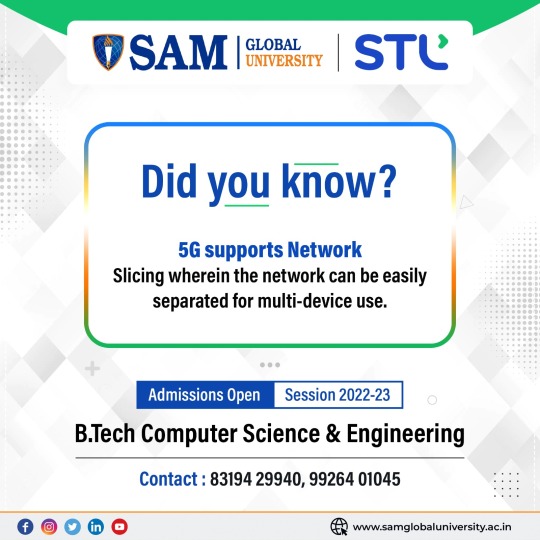
Did you know?
5G supports Network Slicing wherein the network can be easily separated for multi-device use.
Admissions Open Session 2022-23 B.Tech Computer Science & Engineering
Contact: +918319429940, +919926401045
#SAMGlobalUniversity#SAMSterlite#networkslicing#technology#sterlitecourses#technologycourses#computerengineering#5G#techfacts#Btechengineering#gk#facts
0 notes
Text
#Mavenir#defense#5GCore#NetworkSlicing#iceNorway#DefenseTech#Connectivity#electronicsnews#technologynews
0 notes
Text
The evolution of 5GC characteristics
5GC (5G Core Network) is defined as a network with decomposable architecture according to 3GPP. 3GPP also introduces two relative concepts: CUPS (Control and User Plan Separation) and SBI (Service-based Interface) based on HTTP/2 benchmark communication protocol.
With the implementation of cloud-native container, this decomposition of 5G network function software can be supported by both CUPS and SBI.
5G network function can be constructed on the basis of legacy architecture, but only when it is designed and operated on micro-service architecture based on cloud-native container, can 5G NF (Network Function) really make a innovative progression on flexibility, high scalability, resilience, brief operation, life-cycle management and other aspects.
So what’s the characteristic of 5GC?
1. CUPS (Control and User Plan Separation)
In order to separately achieve efficient extension of service in EPC, SGW/PGW is divided into SGW/PGW-C and SGW/PGW-U.
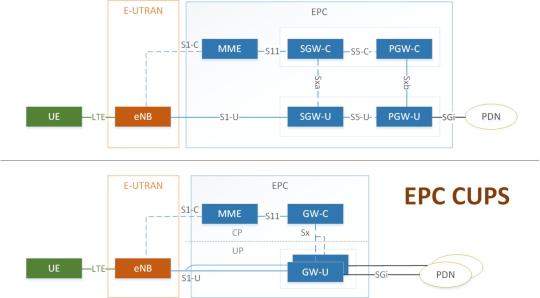
Evolved from 3GPP R14, this kind of separation--CUPS still remains in 5G.
UPF (User Plane Function) only works in the progress of disposing data packet from user traffic, while other single progress will be operated by any other control plane function such as SMF (Session Management Function). By concentrating the control of SMF and dispatching UPF to the edge data centers, the CUPS architecture in 5GC shapes the advantages of lower cost and expansibility.
2. Stateless Architecture
Refer to the standard of 3GPP, stateless architecture is introduced to optimize for a more reliable and flexible network. Under normal circumstance, the contextual information of both user and transmit layer should be reserved by stateful network. Therefore, these data will be reserved when the function is breakdown or any other situations. While stateless architecture is a popular mode based on micro-service software architecture, it has to decouple the application layer and data storage layer with external data storage.
And that’s the reason why UDSF (Unstructured Data Storage Function) is defined by 3GPP.
3. SBI (Service-based Interface)
After the new change of introducing SBI (Service-based Interface) or SBA (Service-based Architecture) from traditional P2P (Peer-to-Peer) network architecture in 5GC control plane, apart from N2, N4 and a few interfaces, most of the interfaces are stipulated to use the same kind of interfaces with HTTP/2 protocol. This change not only helps weaken the dependency of each interface and expand every single function, but also enhances the agility of cross-network function to expand new functions and services.
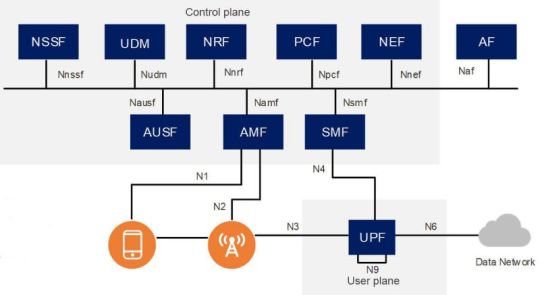
4. Network slicing
With the mature development of NFV (Network Function Virtualization) and SDN (Software-defined Networking), the practical application of cloud-native architecture in 5GC increases sharply. Exploring the possibility to meet specific requirements of customizable network function in every single aspect from various commercial customers, 5GC network slicing enables network operators and enterprises to create and develop new business and monetization opportunities.
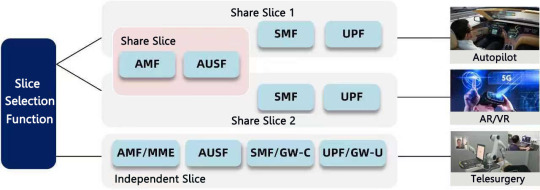
As a leading mobile core network provider, IPLOOK’s full stack cloud-native 5GC includes the full network elements: UPF, AMF, SMF, UDM, AUSF, PCF, NSSF, NEF, NRF, supporting 3GPP and Non-3GPP access. Also, with its high scalable 5GC, IPLOOK provides a fully integrated end-to-end 5G mobile core network solution which can be served in various application scenarios and adapt to specific demands from our customers.

Being adept in constructing customized mobile core network for our customers from all over the world, IPLOOK is eager to provide flexible and cost-saving customized mobile core network solutions. Feel free to contact us and learn more 5GC information at our website!
Click and see IPLOOK Website: https://www.iplook.com/
0 notes
Text
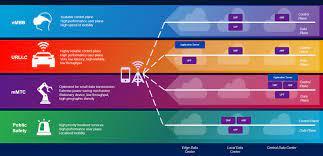
(2024-02-11 image ©viavi) 5G is more than a faster 4G [yes it is faster but that is not all]. There are a number of technologies built into 5G that are designed to give a better service to users - one of which is network slicing.
The idea behind network slicing is that not all uses of the network have the same requirement. For example watching live-sports have a large download (real-time) requirement but little in the way of upload demand; our smart meters and IoT devices have a low data demand.
network slicing allows the networks to split the available frequency up into different slices allowing various Apps or users to have access to a slice better designed for their demands.
Gaming on the mobile network is one application that would benefit from Network Slicing. Players do not want to be delayed as this spoils the game. A large multi-player game could have a dedicated slice.
But here is the problem. Does the allocation of a great eperience for game players have a detremental effect on other users thus conflicting with net-neutrality demands, everyone should have a fair use of the Internet. You can imagine various companies would want a dedicated slice for their product and charge users a premium for the use, thus starting a 2-tier Internet. Currently OfCOM is not worried about network slicing but they are keeping an eye on it.
0 notes
Photo

Check the newest Altice Labs' whitepaper on "5G Intelligent Communications for V2X ecosystems" - bit.ly/WP_5G_Intellig… #5G #IntelligentCommunications #V2X #Platooning #NetworkSlicing https://www.instagram.com/p/CC5oJ4PAwKN/?igshid=woga0hjtzyp0
0 notes
Text
🚀 The future of 5G is here, and it's all about 𝗻𝗲𝘁𝘄𝗼𝗿𝗸 𝘀𝗹𝗶𝗰𝗶𝗻𝗴! 📶 🔹
Imagine being able to customize your network to fit your specific needs.
🔹 With Network Slicing, you can create multiple virtual networks that run on a single physical network.
🔹 Each virtual network can be customized with different network characteristics and functionalities.
🔹 This means that you can have a network dedicated to 𝘃𝗶𝗱𝗲𝗼 𝘀𝘁𝗿𝗲𝗮𝗺𝗶𝗻𝗴 📹, one for 𝗜𝗼𝗧 𝗱𝗲𝘃𝗶𝗰𝗲𝘀 🤖, and another for 𝗲𝘀𝘀𝗲��𝘁𝗶𝗮𝗹 𝗮𝗽𝗽𝗹𝗶𝗰𝗮𝘁𝗶𝗼𝗻𝘀. 🚨🚒👨⚕️👩⚕️🏥
🔹 Network Slicing is revolutionizing the way we think about network architecture and is paving the way for a truly customizable and efficient 5G network. Stay ahead of the game and learn more about Network Slicing today!
💡 Click the link to know more: https://bit.ly/3mUJqpA
#5G #5Gnetworkslicing #networkslicing #5Gtechnology #innovation #telecommunications #mobilenetworks #virtualnetworks #flexibility #efficiency #productivity #digitaltransformation #IoT #criticalapplications #customization #smartcities #connectedvehicles #telemedicine #virtualreality
0 notes
Text
Telecom Monetization

In the 5G era, customers demand seamless experiences across various channels, including web, mobile, social media, and POS (point of sale). A modernized BSS system not only ensures these seamless experiences but also enables operators to monetize interactions effectively. By providing consistent branding, pricing, and service experiences across all touchpoints, operators can enhance revenue potential while fostering customer loyalty and retention.
Moreover, telecom monetization strategies include leveraging network slicing to offer tailored services for different customer segments, implementing dynamic pricing models, and forming strategic partnerships with content providers. Operators can also introduce value-added services like cloud and edge computing for enterprises, further boosting revenue streams. By integrating these approaches, telecom operators can maximize the profitability of their 5G networks and stay competitive in the rapidly evolving market.
0 notes